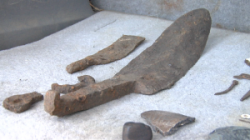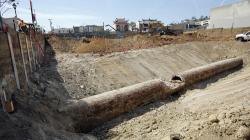INSTITUT SUPERIEUR D'ANTHROPOLOGIE
INSTITUTE OF ANTHROPOLOGY
ONLINE COURSES / COURS A DISTANCE
SUMMER TERM : JULY 2014
REGISTER NOW
USA –  Redstone Arsenal - Redstone Arsenal is 38,000 acres of protected government land that is literally hiding hundreds of secrets. The Tennessee Valley is rich with history, much of it on display for all to learn from and enjoy, and some of it buried, waiting to be uncovered. One man is on a mission to unearth whats hidden beneath the post, his name is Ben Hoksbergen."I think we are up to 980 archaeological sites that have been recorded on Redstone so far," explained Hoksbergen. “We are standing on the site of a probably 1820 to 1840's blacksmith shop,” he continued. The site is just feet from a main road and is surrounded Homes, centers of trade, even burial sites, from 80 acres wide to only 20 feet across Hoksenberg has found many different settlements and, truth be told, many of the historical artifacts are hiding in plain sight. "I was walking along the roadway here and noticed material that I recognized as blacksmith material,” he said while on site at the dig, “like coal slag, and horse shoe nails, and fragments of metal waste.” Remnants of what was apparently once a booming blacksmith shop are still lying at the edge of the woods, visible to anyone who takes the time to look. Hoping to find more, he and his contracted team went to work. They did not come up empty handed. Large stones were found just below the top layer of soil. The stones may be part of a forge or they may be a wall, the group doesn't know yet. Hoksbergen says there is no way to know how long the dig will take, it all depends on how much of the structure remains. More signs of a time long since past, are nearby. Over the entire site we have got little prehistoric camps."He says some of the artifacts date back to prehistoric times and include spearheads, pottery, and rudimentary tools. Discoveries that date back to the more recent history include pieces of dolls and toy trains, belt buckles, and shovels. The earliest settlers leaving behind small pieces of their lives for us to find, study, and learn from.
Redstone Arsenal - Redstone Arsenal is 38,000 acres of protected government land that is literally hiding hundreds of secrets. The Tennessee Valley is rich with history, much of it on display for all to learn from and enjoy, and some of it buried, waiting to be uncovered. One man is on a mission to unearth whats hidden beneath the post, his name is Ben Hoksbergen."I think we are up to 980 archaeological sites that have been recorded on Redstone so far," explained Hoksbergen. “We are standing on the site of a probably 1820 to 1840's blacksmith shop,” he continued. The site is just feet from a main road and is surrounded Homes, centers of trade, even burial sites, from 80 acres wide to only 20 feet across Hoksenberg has found many different settlements and, truth be told, many of the historical artifacts are hiding in plain sight. "I was walking along the roadway here and noticed material that I recognized as blacksmith material,” he said while on site at the dig, “like coal slag, and horse shoe nails, and fragments of metal waste.” Remnants of what was apparently once a booming blacksmith shop are still lying at the edge of the woods, visible to anyone who takes the time to look. Hoping to find more, he and his contracted team went to work. They did not come up empty handed. Large stones were found just below the top layer of soil. The stones may be part of a forge or they may be a wall, the group doesn't know yet. Hoksbergen says there is no way to know how long the dig will take, it all depends on how much of the structure remains. More signs of a time long since past, are nearby. Over the entire site we have got little prehistoric camps."He says some of the artifacts date back to prehistoric times and include spearheads, pottery, and rudimentary tools. Discoveries that date back to the more recent history include pieces of dolls and toy trains, belt buckles, and shovels. The earliest settlers leaving behind small pieces of their lives for us to find, study, and learn from.
http://www.waaytv.com/appnews/buried-secrets-at-redstone-arsenal/article_d0d29442-e092-11e3-985e-0017a43b2370.html
CHINE –  Dazu - It's a rare treat when a treasure can be found within a treasure. That's exactly what happened when archaeologists uncovered a hidden gem, buried deep inside a centuries-old, thousand-hand bodhisattva statue in south west China, at the Dazu Rock Carvings.Engraved tablets, golden foil and pieces of porcelain retrieved from the inside of one of China's most prized treasures. They were uncovered from this thousand-hand bodhisattva, the most famous among the The Dazu Rock Carvings. Archaeologists discovered a chamber in the abdomen of the statue. Within, they found a stone tablet with red engravings on it. The engravings are dated to the reign of Emperor Qianlong, over 300 years ago.Still legible, they are believed to be prayers for blessings and good fortune.Archaeologists discovered possible openings in the statue back in 2008. After careful examination, they confirmed that there was an irregular enclosed space in the statue's abdomen. Grain and jewellery were also be found within.The thousand-hand bodhisattva was created about 800 years ago during the Southern Song dynasty. It is carved on a cliff at 15-30 meters above ground and has 830 arms. The Dazu Rock carvings was listed as a World Culture Heritage Site in 1999 by UNESCO.
Dazu - It's a rare treat when a treasure can be found within a treasure. That's exactly what happened when archaeologists uncovered a hidden gem, buried deep inside a centuries-old, thousand-hand bodhisattva statue in south west China, at the Dazu Rock Carvings.Engraved tablets, golden foil and pieces of porcelain retrieved from the inside of one of China's most prized treasures. They were uncovered from this thousand-hand bodhisattva, the most famous among the The Dazu Rock Carvings. Archaeologists discovered a chamber in the abdomen of the statue. Within, they found a stone tablet with red engravings on it. The engravings are dated to the reign of Emperor Qianlong, over 300 years ago.Still legible, they are believed to be prayers for blessings and good fortune.Archaeologists discovered possible openings in the statue back in 2008. After careful examination, they confirmed that there was an irregular enclosed space in the statue's abdomen. Grain and jewellery were also be found within.The thousand-hand bodhisattva was created about 800 years ago during the Southern Song dynasty. It is carved on a cliff at 15-30 meters above ground and has 830 arms. The Dazu Rock carvings was listed as a World Culture Heritage Site in 1999 by UNESCO.
http://english.cntv.cn/2014/05/21/VIDE1400603399381149.shtml?
USA –  Los Angeles - It’s not terribly surprising that a construction crew, working on a development in Chinatown, came across a 100-foot section of Los Angeles’ first municipal water system — the famous Zanja Madre, or “Mother Ditch.” The bigger question is what to do with it.The Zanja Madre was built as an open ditch in 1781 and over time morphed into an elaborate network of pipes. It was enclosed in 1877 and abandoned in 1904.
Los Angeles - It’s not terribly surprising that a construction crew, working on a development in Chinatown, came across a 100-foot section of Los Angeles’ first municipal water system — the famous Zanja Madre, or “Mother Ditch.” The bigger question is what to do with it.The Zanja Madre was built as an open ditch in 1781 and over time morphed into an elaborate network of pipes. It was enclosed in 1877 and abandoned in 1904.
http://www.latimes.com/opinion/opinion-la/la-ol-zanja-madre-ground-chinatown-20140519-story.html
PEROU –  Chaquira - Archaeologists working in the northern Peruvian region of Piura recently discovered an administrative complex that they believe was constructed by the Tallan culture. El Comercio reports that investigations at the site began their excavation in two ditches near the town of Chaquira. Locals said that beads and small artifacts were sometimes found in and around the ditches. Head archaeologist María Elena Nuñera Paredes told El Comercio that “This would have been a large warehouse with corn, cotton, and other products from the area. At another time, it served as a space where the Tallan lived.” Nuñera explained that the artifacts found within the structures by her team led them to the determination that they were dealing with an administrative complex. “The structures that we have found are similar to those that exist in Narihuala. Inside the objects that we found, there are ceramics polishers and ceramics fragments with different designs. It was an administrative center for the Tallan people, and was controlled by a chief,” said Nuñera. The Tallan people lived in Piura between 1000 AD and 1200 AD. The exact age of the structure is unknown at this time. According to El Comercio, archaeologists worked for a month before announcing their discovery.
Chaquira - Archaeologists working in the northern Peruvian region of Piura recently discovered an administrative complex that they believe was constructed by the Tallan culture. El Comercio reports that investigations at the site began their excavation in two ditches near the town of Chaquira. Locals said that beads and small artifacts were sometimes found in and around the ditches. Head archaeologist María Elena Nuñera Paredes told El Comercio that “This would have been a large warehouse with corn, cotton, and other products from the area. At another time, it served as a space where the Tallan lived.” Nuñera explained that the artifacts found within the structures by her team led them to the determination that they were dealing with an administrative complex. “The structures that we have found are similar to those that exist in Narihuala. Inside the objects that we found, there are ceramics polishers and ceramics fragments with different designs. It was an administrative center for the Tallan people, and was controlled by a chief,” said Nuñera. The Tallan people lived in Piura between 1000 AD and 1200 AD. The exact age of the structure is unknown at this time. According to El Comercio, archaeologists worked for a month before announcing their discovery.
http://www.peruthisweek.com/news-archaeologists-discover-ancient-administrative-complex-in-northern-peru-103001
IRAK /SYRIE – 

 Tell Ajaja - According to a report from the websitewww.apsa2011.com, the Islamic State of Iraq and the Levant (ISIL, also known as ISIS) has destroyed Assyrian statues and artifacts believed to be 3000 years old. The Assyrian archaeological artifacts were illegally excavated from the Tell Ajaja site. Looting of Assyrian artifacts was also carried out in Iraq soon after 2003 by Al-Qaeda, which sold the artifacts to finance its operations. The looting occurred at the Baghdad Museum (AINA2003-04-19) as well as archaeological sites which were left unguarded as a result of the collapse of the government of Saddam Hussein (AINA 2005-02-17).
Tell Ajaja - According to a report from the websitewww.apsa2011.com, the Islamic State of Iraq and the Levant (ISIL, also known as ISIS) has destroyed Assyrian statues and artifacts believed to be 3000 years old. The Assyrian archaeological artifacts were illegally excavated from the Tell Ajaja site. Looting of Assyrian artifacts was also carried out in Iraq soon after 2003 by Al-Qaeda, which sold the artifacts to finance its operations. The looting occurred at the Baghdad Museum (AINA2003-04-19) as well as archaeological sites which were left unguarded as a result of the collapse of the government of Saddam Hussein (AINA 2005-02-17).
http://www.aina.org/news/20140517025551.htm